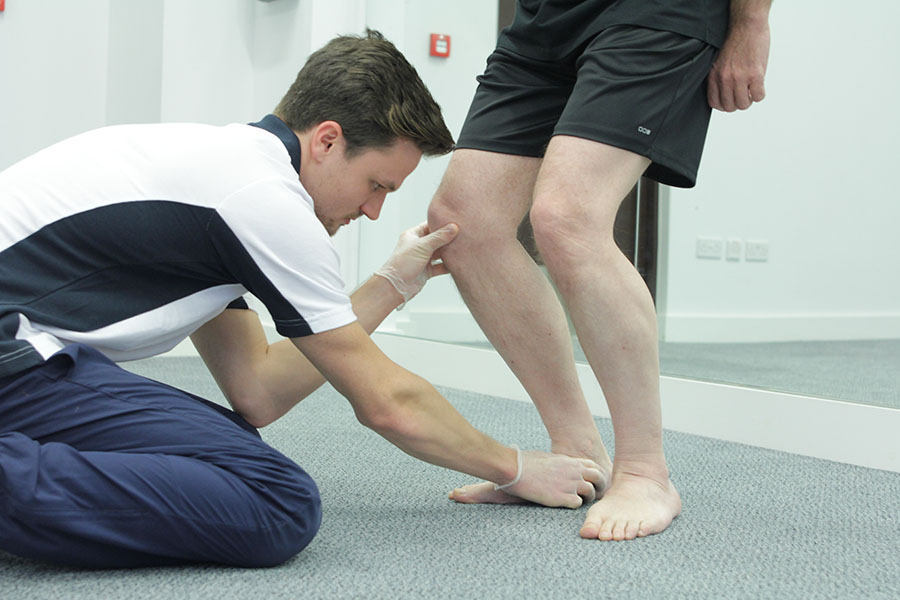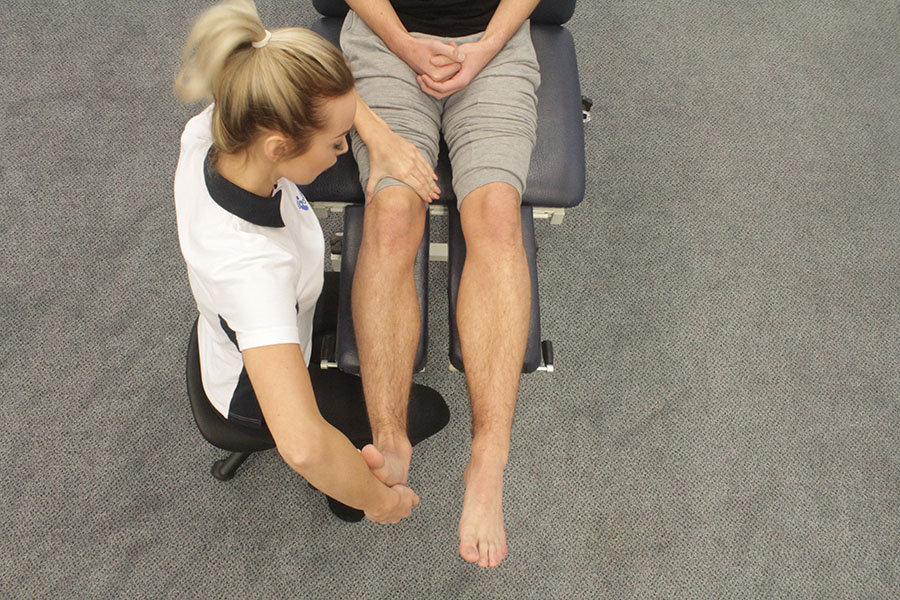Medial tibial stress syndrome
Medial tibial stress syndrome, sometimes referred to as shin splints, presents as pain along the front of the shin bone. Medial tibial stress syndrome is a complaint often seen in runners, dancers, and athletes; however, medial tibial stress syndrome can affect anyone.
What is medial tibial stress syndrome?
Medial tibial stress syndrome is a painful condition that is the result of overuse, it is therefore considered to be an over-use injury. Medial tibial stress syndrome presents as pain down the front inner side of the shin where the tibialis posterior and soleus muscles attach, and is a condition that is typically seen in athletes; particularly runners. The pain associated with medial tibial stress syndrome is exercise induced, this means that the pain occurs upon, and during exercise.

What causes medial tibial stress syndrome?
Medial tibial stress syndrome occurs when too much force is placed on the connective tissues that attach the soleus and the tibialis posterior muscle to the shin bone. Often the excessive force associated with medial tibial stress syndrome is caused by poor foot and lower limb mechanics, which creates extra pull on these connective tissues. A poor training regime can also produce medial tibial stress syndrome, the most common errors that people make when training include:
- Running in footwear that has worn out and/or not suitable for purpose
- Downhill running
- Running on uneven surfaces
- Rapidly increasing training
- Beginning activity (doing too much too soon) after a long period of inactivity
What are the signs and symptoms of medial tibial stress syndrome?
The signs and symptoms of medial tibial stress syndrome include:
- Pain and tenderness on the inside of the shin, often this pain can be isolated to a particular spot. The pain associated with medial tibial stress syndrome comes on with exercise.
- Pain may be dull at first but can become sharp
- Pain may be worse when the ankle and toes are plantarflexed (point down). This is because the soleus and tibialis posterior are responsible for plantarflexion of the foot and ankle
- Redness
- Swelling
If you experience any of the above symptoms, please visit Chiropody.co.uk for an assessment.
How is medial tibial stress syndrome diagnosed?
It is important to correctly diagnose media tibial stress syndrome, as
there are a number of conditions that can cause pain at the shin, for
example, stress fractures.
One of our podiatrists here at Chiropody.co.uk will make a diagnosis based
on a thorough history, the signs and symptoms, and an examination.
Typically, the pain that occurs as a result of medial tibial stress
syndrome is located approximately 3-12cm above the ankle bone on the inside
of the leg. Once a diagnosis of medial tibial stress syndrome has been made
it is important to find the cause, our podiatrists will therefore assess
you biomechanically, which includes assessing the way you walk (gait
analysis).
If a stress fracture is suspected, you may be referred for an X-ray or
scan.

Benefit of podiatry for medial tibial stress syndrome
If you have medial tibial stress syndrome podiatry will benefit you. The treatment benefits that may be achieved through podiatry intervention include:
- Pain relief
- Improved lower limb mechanics/function
- Improved muscle strength
- Reduction in muscle tightness
- Reduced injury risk
- Improved gait
Podiatric treatment benefits are achieved by treating the cause of medial
tibial stress syndrome, as well as the symptoms. Poor foot and lower limb
mechanics put structures under more stress that they would otherwise be
subject to, which force compensatory mechanisms to occur. The result is
muscle tightness, weakness, pain, and injury.
At Chiropody.co.uk we use orthoses to improve the mechanics of the lower
limb and foot. Pain is reduced due to the orthoses ability to offload the
painful structure.
Any muscle tightness or weakness is improved upon using a variety of soft
tissue treatment methods, alongside an appropriate stretching and
strengthening programme.
What would podiatry for medial tibial stress syndrome involve?
A visit to Chiropody.co.uk for medial tibial stress syndrome would involve the following:
- Obtaining a medical history
- Obtaining a history of the problem
- An examination of the area
- A biomechanical assessment
- Gait analysis
- A footwear assessment
- An explanation as to the cause of your problem and what we can do about it
- An explanation as to how any intervention we prescribe will help
Once a diagnosis of medial tibial stress syndrome has been made and the cause has been established, one or more of the following treatments may be recommended:
- Anti-inflammatory advice
- Rest
- Orthoses
- Footwear review
- Strengthening Exercises
- Stretching Programmes
- Massage
- Taping
- Joint mobilization
- Ultrasound
- Advice and education
- Weight loss advice if appropriate
- Review of training
- Non-impact exercise
The aim of treatment for medial tibial stress syndrome is to reduce any pain and inflammation and to ensure that your foot and lower limp are functioning efficiently.
Summary
Medial tibial stress syndrome is an overuse injury that produces pain on
the inside of the shin bone; this is where the tibialis posterior and
soleus muscle attach. Medial tibial stress syndrome is often seen in
runners, however, it can affect anyone.
If you have medial tibial stress syndrome it is important to visit a
podiatrist. Our podiatrists here at Chiropody.co.uk have the skills to
correctly diagnose your condition and provide you with a treatment plan
designed to not only reduce any pain associated with the condition, but
that can also improve the function of your lower limb.
To arrange an assessment with one our podiatrists please email office@chiropody.co.uk or call 0330 088 4222.
Save 5% by booking an appointment online.



We work with:

Individuals

Organisations

Health professionals
Get in Touch!
0330 088 4222
If you would like to speak to one of our specialists then please complete this form.
We are open 7 days a week








